Page 202 of 306
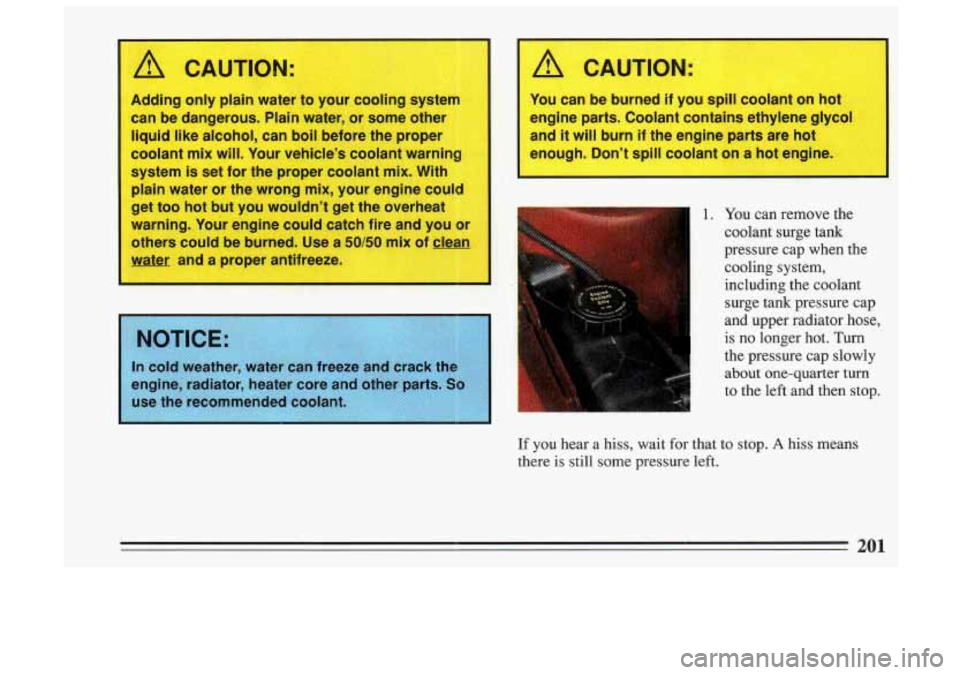
1
A CAUTION':
Adding only plain water to your cooling system
can be dangerous. Plain water, or some lother
liquid li~ke alcohol, can boil before tihe proper
coolant
mix will. Your whicl'e's CoOilant warning
You can1 be burned if you spill coolant on hot ,,
engilne ~parts. Coolaint contains ethylene glycol
and lit wil~il burn if the enlgine parts are ,hot
enough. hn't spill coolant
on a hot engine. I
system is set for the proper coolant mix. With
plain water or the wron.g, mix, your engi'ne could8 1
get too h,ot but you wouldn't get thie overheat
warning. Your engine could catclh fire and
you or
others could
be burned. Use ;a 50/50 mix of clean
water and a proper antifreeze.
1
I
1-
1. You can remove the
coolant surge tank
pressure cap when the
cooling system,
including the coolant
surge
tank pressure cap
and upper radiator hose,
is no longer hot. Turn
the pressure cap slowly
i about one-quarter turn
1 to the left and then stop. I
If you hear a hiss, wait for that to stop. A hiss means
there is still some pressure left.
201
Page 204 of 306
4.
5. By this time, the coolant level inside the coolant
surge tank may be lower. If the level is lower, add
more of the proper mix to the coolant surge tank
until the level reaches the split line formed by the
black and white part of the tank.
With the coolant surge tank pressur\e cap off, start the
engine and let it run until you can feel the upper
radiator hose getting hot. Watch out for the engine
6. Then replace the
pressure cap. Be sure
the pressure cap is tight.
fan.
203
Page 223 of 306
I1
A CAUTION:
An electric fan under the hood can start up and
injure you even when the engine is not running
Keep hands, clothing and tools away from any
underhood electric fan.
CAUTION:
Things that burn can get on hot engine parts and
start a fire. These include liquids like gasoline,.
oil, coolant, brake fluid, windshield washer and
other fluids, and plastic or rubber. You or others
I could be burned. Be careful not to drop or spill
things that
will burn onto a hot engine.
I
Before closing the hood, be sure all the filler caps are on
properly.
Then just pull the hood down and close it firmly. '
Page 233 of 306
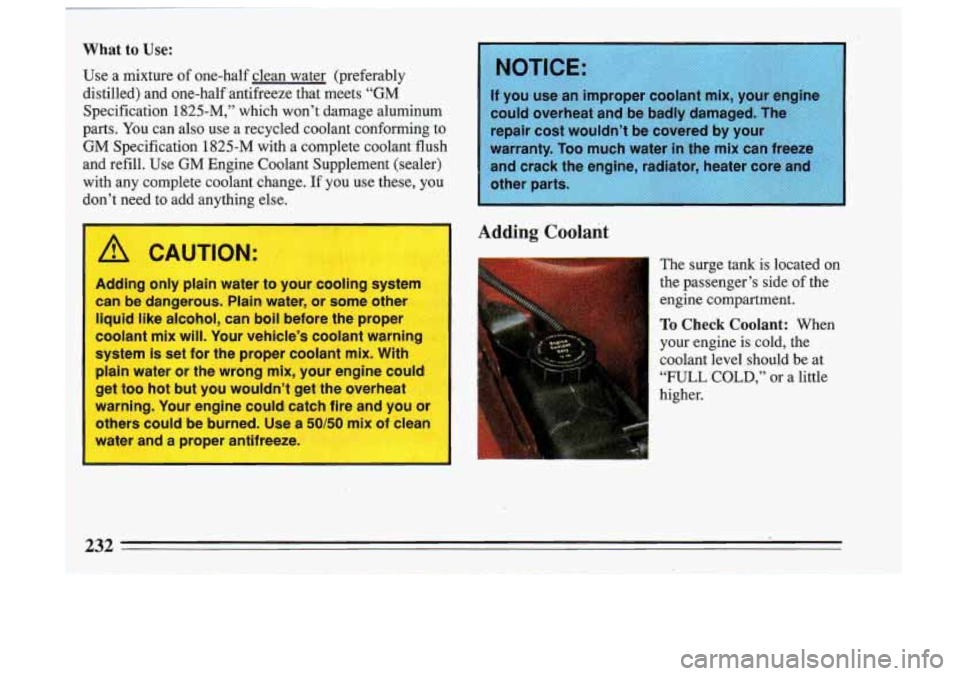
~~~x~~~~ of one-half clean water (preferably
distilled) and one-half antifreeze that meets
“GM
Specification 1825-M,” which won’t damage aluminum
parts. You can also use a recycled coolant conforming to
GM Specification 1825-M with a complete coolant-flush
and refill. Use
GM Engine Coolant Supplement (sealer)
with any complete coolant change. If you use these, you
don’t need to add anything else.
n
1 A CAUTION:
Adding only plain water to your cooling system
can be dangerous. Plain water, or some other
liquid like alcohol, can boil before the proper
coolant mix will. Your vehicle’s coolant warning
system is set for the proper coolant mix. With
plain water or the wrong mix, your engine could
get too hot but you wouldn’t get the overheat
warning. Your engine could catch fire and you or
others could be burned. Use a
50150 mix of clean
water and a proper antifreeze.
I
warrantv. Too much water in the mix can freeze
Adding Coolant
The surge tank is located on
the passenger’s side
of the
engine compartment.
To Check Coolant: When
.your engine is cold, the
coolant level should be at
“FULL COLD,” or a little
higher.
Page 234 of 306
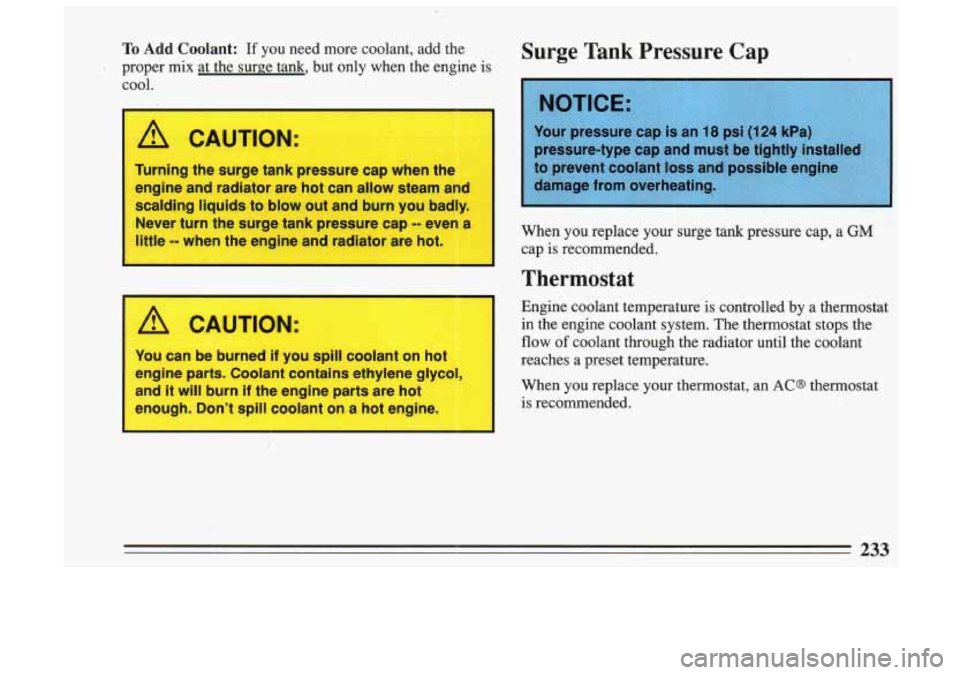
To Add Coolant: If you need more coolant, add the
proper mix at the surge tank, but only when the engine is cool.
A CAUTION:
Turning the surge tank pressure cap when the
engine and radiator are hot can allow steam and
scalding liquids to blow out and burn you badly.
Never turn the surge tank pressure cap
-- even a
little
-- when the engine and radiator are hot.
I
I
1 A CAUTION:
You can be burned if you spill coolant on hot
engine parts. Coolant contains ethylene glycol,
and
it will burn if the engine parts are hot
enough. Don’t spill coolant
on a hot engine.
1
Surge Tank Pressure Cap
pressure-type cap and must be tightly installed
When you replace your surge tank pressure cap, a GM
cap is recommended.
Thermostat
Engine coolant temperature is controlled by a thermostat
in the engine coolant system. The thermostat stops the
flow of coolant through the radiator until the coolant
reaches a preset temperature.
When you replace your thermostat, an
ACS thermostat
is recommended.
233
Page 275 of 306
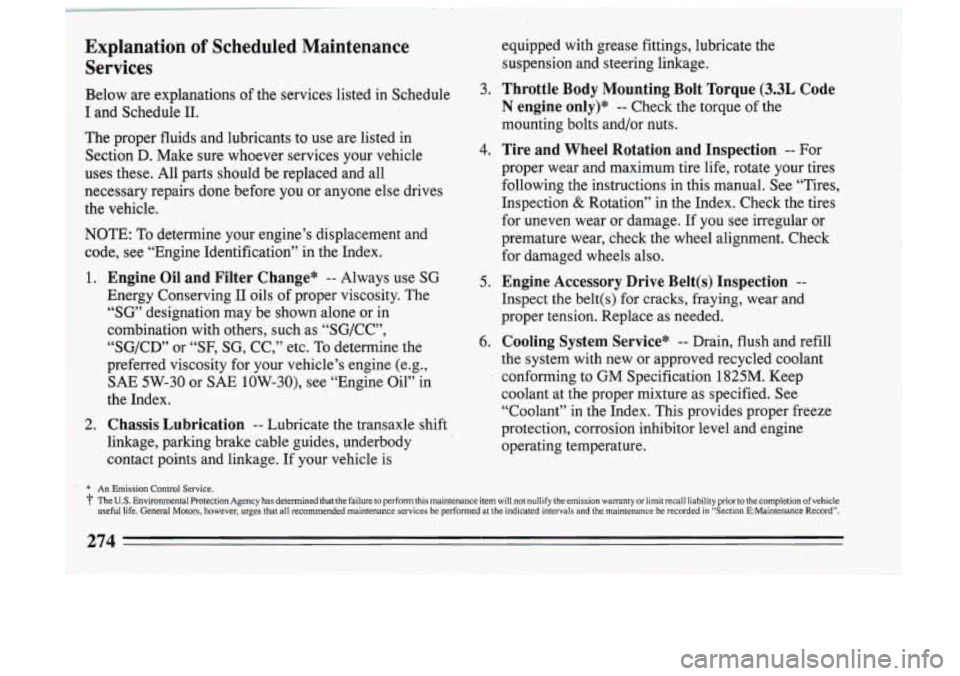
Explanation of Scheduled Maintenance equipped with grease fittings, lubricate the
Services suspension and steering linkage.
Below are explanations
of the services listed in $chediie ‘ ‘ 3. Throttle Body Mounting; Bolt Torque (3.3L Code . , I:
I and Schedule 11.
The proper fluids and lubricants to use are listed in
Section
D. Make sure whoever services your vehicle
uses these. All parts should be replaced and all
necessary repairs done before you or anyone else drives
the vehicle.
NOTE:
To determine your engine’s displacement and
code, see “Engine 1dentific.ation” in the Index.
1. Engine Oil and Filter Change* -- Always use SG
Energy Conserving
I1 oils of proper viscosity. The
“SG, designation may be shown alone or in
combination with others, such as “SG/CC”,
“SG/CD” or “SF,
SG, CC,” etc. To determine the
preferred viscosity for your vehicle’s engine (e.g.,
SAE 5W-30 or SAE 10W-30), see “Engine Oil” in
the Index.
2. Chassis Lubrication -- Lubricate the transaxle shift
linkage, parking brake cable guides, underbody
contact points and linkage. If your vehicle is
An Emission Control Service.
N engine only)* -- Che& the torque of the
mounting bolts and/or nuts.
proper wear and maximum tire life, rotate your tires
following the instructions in this manual. See “Tires,
Inspection
& Rotation” in the Index, Check the tires
for uneven wear or damage. If you see irregular or
premature wear, check
the wheel alignment. Check
for damaged wheels also.
5. Engine Accessory Drive Belt@) Inspection --
Inspect the belt(s) for cracks, fraying, wear and
proper tension. Replace as needed.
6. Cooling System Service* -- Drain, flush and refill
the system with new or approved recycled coolant
conforming to GM Specification 1825M. Keep
coolant at the proper mixture as specified. See
“Coolant” in the Index. This provides proper freeze
protection, corrosion inhibitor level and engine operating temperature.
4. Tire and Wheel Rotation and Inspection -- For
The U.S. Environmental Protection Agency has determined that the failure to perform this maintenance item will not nullify the emission war\
ranty or limit recall liability prior to the completion of vehicle
useful life. General Motors, however, urges that all recommended maintenance services be performed at the indicated i\
ntervals and the maintenance be recorded in “Section EMaintenance Record”.
274
Page 277 of 306
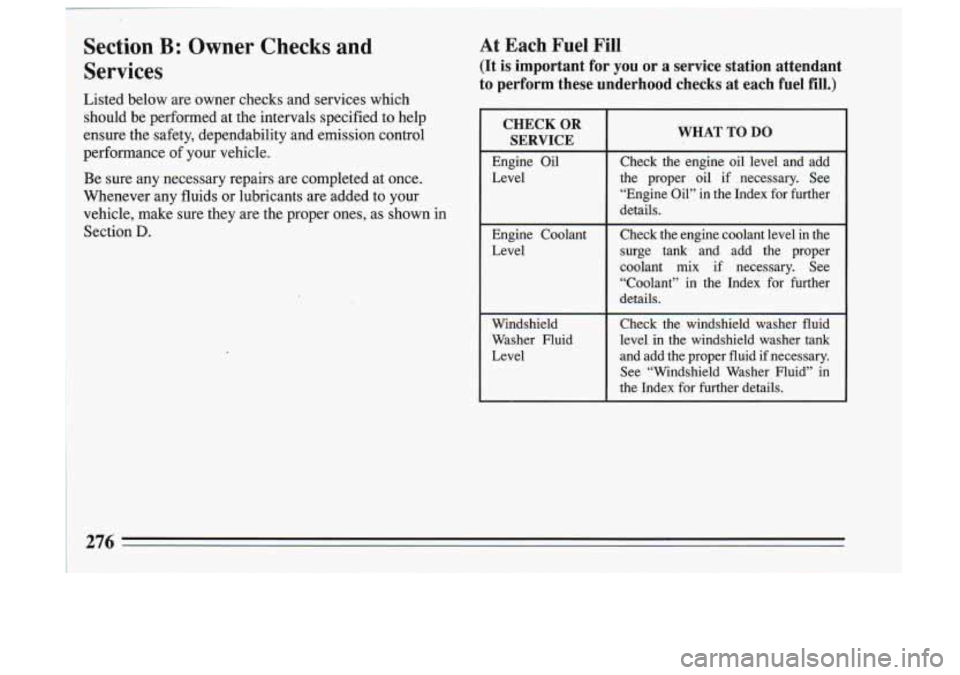
Section €5: Owner Checks and
Services
I Listed below are owner checks and services which
should be performed at the intervals specified to help
ensure the safety, dependability and emission control
performance of your vehicle.
Be sure any necessary repairs are completed at once.
Whenever anv fluids or lubricants are added to vour
At Each Fuel Fill
(It is important for you or a service station attendant
to perform these underhood checks at each fuel
fill.)
CHECK OR
I SERVICE I WHAT TO DO
Engine Oil Check the engine oil level and add
Level the proper oil if necessary. See
“Engine
Oil“ in the Index for further .r .I
vehicle, make sure they are the proper ones, as shown in details.
Section D. Engine Coolant Check the engine coolant level in the
Level surge tank and add the proper
coolant mix
if necessary. See
“Coolant” in the Index for further
details.
Windshield Check the windshield washer fluid
Washer Fluid level in the windshield washer tank
Level and add the proper fluid
if necessary.
See “Windshield Washer Fluid” in
the Index for further details.
Page 282 of 306
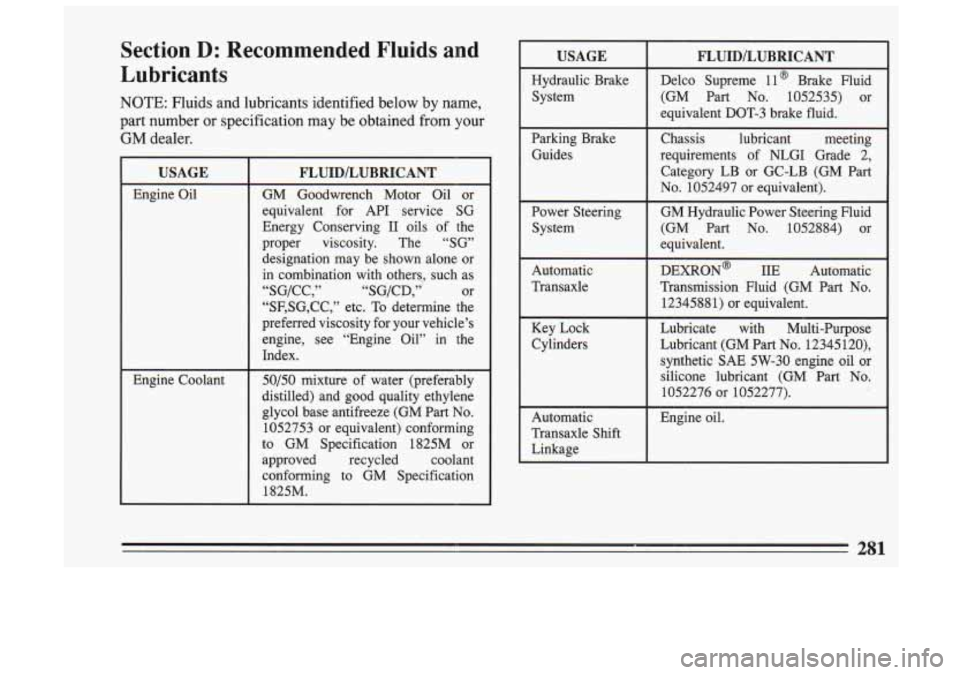
Section D: Recommended Fluids and
Lubricants
NOTE: Fluids and lubricants identified below by name,
part number or specification may be obtained from your
GM dealer.
USAGE
Engine Oil
Engine Coolant
FLUID/LUBRICANT
GM Goodwrench Motor Oil or
equivalent for API service SG
Energy Conserving I1 oils of the
proper viscosity. The
“SG’
designation may be shown alone or
in combination with others, such as
“SGICC,”
66~~/~~,991 or
“SF,SG,CC,” etc. To determine the
preferred viscosity for your vehicle’s
engine, see “Engine Oil” in the
Index.
50/50 mixture of water (preferably
distilled) and good quality ethylene
glycol base antifreeze (GM Part No.
1052753 or equivalent) conforming
to GM Specification 1825M or
approved recycled coolant
conforming to GM Specification
1825M.
USAGE
Hydraulic Brake
System
Parking Brake
Guides
Power Steering
System
Automatic
Transaxle
Key Lock
Cylinders
Automatic
Transaxle Shift
Linkage
FLUIDlLUBRICANT
~~
Delco Supreme 11 @ Brake Fluid
(GM Part No. 1052535) or
equivalent DOT-3 brake fluid.
Chassis lubricant meeting
requirements of NLGI Grade 2,
Category LB or GC-LB (GM Part
No. 1052497 or equivalent).
GM Hydraulic Power Steering Fluid
(GM Part No. 1052884) or
equivalent.
DEXRON@ IIE Automatic
Transmission Fluid (GM Part
No.
12345881) or equivalent.
Lubricate with Multi-Purpose
Lubricant (GM Part
No. 12345120)’
synthetic
SAE 5W-30 engine oil or
silicone lubricant
(GM Part No.
1052276 or 1052277).
Engine oil.
281